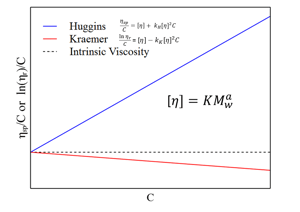When comparing viscometers, the primary differentiators are typically:
- Does it measure dynamic or kinematic viscosity?
- Can it measure non-Newtonian samples?
- What sample volume is required?
- How easy it is to obtain a viscosity measurement?
RheoSense has taken the design of our viscometers one step further with our patented VROC® (Viscometer-Rheometer-on-a-Chip) technology, combining microfluidic and MEMS (Micro-Electro-Mechanical Systems) technologies, allowing for complete characterization of viscosity as a function of shear rate or temperature. What may be the most differentiating feature of our VROC powered viscometers is their exceptional repeatability and accuracy which makes them the only viscometers available today with the necessary capabilities to provide intrinsic viscosity measurements.
Intrinsic viscosity can be defined as “a measure of a solute’s contribution to the viscosity of a solution”, or more specifically an increase in viscosity as a result of adding an infinitesimal amount of solute to a solvent. To determine the intrinsic viscosity, you must measure the viscosity of your solution at different concentrations and then apply the Huggins and Kraemer equation. The intrinsic viscosity is a reliable and sensitive indicator of a solute’s molecular interaction with a solvent, and can be used to determine the molecular properties of a sample, such as:
- Molecular weight and size
- Polymerization
- Interaction of molecules
- Degradation
- Branching structure
- Stability of molecules: aggregation, denaturation, or conformational changes of protein molecules
- Protein structure and melting temperatures
The key to accurately measuring intrinsic viscosity is repeatability. Our VROC powered viscometers offer exceptional repeatability (0.5% of reading), which ensures that you are able to quickly and easily obtain highly accurate (2%), reliable results using small samples. Our new VROC initium one plus is much more than a traditional viscometer; it is a workhorse for your material characterization. Below are just some of the most common molecular characterizations for which our customers are using their VROC initium one plus:
Injectability 
In protein therapeutics, major resources are dedicated toward the development of self-injection formulations for:
- Sustainable Release
- Subcutaneous Injection
The injection force required for an injectable solution is important in early formulation and development of an auto-eject system. Understanding the viscosity at the shear rate inside your needle is crucial to estimating an accurate injection force, which has a direct impact on both efficacy and patient experience.
Stability (Tm)
Proteins naturally want to be unstable, however when it comes to drug formulation too much instability will cancel out effectiveness. Protein stability depends on temperature, pH, and concentration along with many other factors and is a critical factor in protein drug formulation, drug efficacy, and storage shelf life. Direct light scattering or circular dichroism techniques are frequently used to study protein aggregation or unfolding. These methods, however, require a dilute concentration for accuracy and a concentration of 100 mg/ml is likely too high for the light scattering technique. The detection range of our VROC® technology is not limited to low concentrations, and has shown that small increase in viscosity due to unfolding or denaturation can be detected without needing to dilute your sample.
Protein interactions 
Ionic strength is a key formulation parameter to control the viscosity of protein solutions and a key parameter in determining the macroscopic behavior of protein solutions (along with pH). Dilute solution viscosity measurements can help to reveal the primary types of interactions controlling formulation behavior. Dilute solution viscosity data is highly sensitive to changes in the protein-protein interactions that can occur with formulation variations. The VROC initium one plus simplifies intrinsic viscosity measurement and makes protein characterization and optimization more convenient than traditional methods.
Protein sizing 
Mark–Houwink–Sakurada (MHS) equation is used to calculate molecular weight from intrinsic viscosity and the Einstein-Simha equation is used to determine hydrodynamic radius, or size, of molecules. This hydrodynamic radius indicates the interaction of the protein molecules with media. With our VROC initium one plus molecular size can be calculated from the intrinsic viscosity measurement even if the media contains other protein molecules.
Protein denaturation 
As protein molecules unfold or aggregate viscosity increases, making viscosity an effective tool to monitor the stability of a drug and an important parameter when optimizing injectable drugs. RheoSense VROC viscometers are designed to detect these small changes in viscosity using only a small sample, making them a useful tool for investigating drug stability without needing to dilute your sample.
Formulation optimization 
Injectability is a key characteristic in assessing safety and efficacy of candidate mAb’s and is solely dictated by the viscosity of the formulation, making viscosity critically important in characterization during the development process. Higher viscosities in injections can cause major problems as it is difficult to inject high viscosity medicine into the patient without causing physical pain. This can make mAb formulation challenging as drug stability must be achieved with the lowest viscosity values possible. The VROC initium one plus measures viscosity of protein solutions accurately and with high repeatability, helping easily and accurately identify the lowest viscosity value of your formulation.
Formulation differentiation 
Due to the sensitivity of VROC initium one plus measurements, we are able to detect very small changes in viscosity from minor changes in the formulation (i.e. small changes in salt concentration, salt type, pH, excipients, etc). With the VROC initium one plus we even have the ability to determine which component is contributing the most to the viscosity difference even when the change is incremental. The ability to detect these small changes are highlighted in our "Viscosity of Fetal Bovine Serum and Media Formulations" application note, in which we were able to detect the contribution of both Fetal Bovine Serum and D-glucose to formulation even with a difference in FBS of 2.5% to 5% and a difference in D-glucose of 1 g/L versus 4.5 g/L.
Candidate drug screening 
During the drug formulation process, scientist consider numerous proteins individually and as a combination with one another. Screening all candidates to find best candidate for screening and trials all the way through FDA approval to prevent project elimination in late stage approval saves both time and money. With the VROC initium one plus we unlock the process of what we call “viscosity fingerprinting” –thorough characterization of viscosity under any number of physical parameters to map out the detailed rheological properties of your product. With limited volumes of candidate formulations typically available early in the development cycle, the ability to accurately and reliably measure viscosity in small samples is vital to success of the development program.
The ability to test and determine all the above is driven by superior repeatability, fast, convenient, ease of use and small sample volume capabilities. These repeatable and precise measurements were conventionally measured by capillary viscometers; however, this technique is very time consuming and labor intensive, requiring large sample sizes and cleaning between each concentration measurement. With RheoSense’s VROC powered initium one plus you are able to use a small sample size to get an accurate set of data points in a quick succession without having to flush between different concentrations, making this process faster, easier and more reliable than conventional techniques.

10 reasons RheoSense VROC initium one plus makes sense:
- Small sample volume
- Ease of use
- Rapid results
- High precision, accuracy, and repeatability
- “True” viscosity measurements
- Closed system (no solvent evaporation or contamination)
- Widest viscosity and shear rate range capabilities
- Newtonian and non-Newtonian fluid measurement
- Small footprint
- Utility
Written by: Eden Reid, RheoSense Senior Marketing Associate



